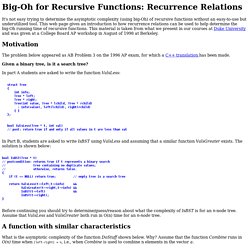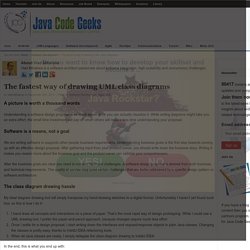Algorithm
> Mbarcikowski
Algorithm Tutorials. Big-Oh for Recursive Functions: Recurrence Relations. It's not easy trying to determine the asymptotic complexity (using big-Oh) of recursive functions without an easy-to-use but underutilized tool.

This web page gives an introduction to how recurrence relations can be used to help determine the big-Oh running time of recursive functions. This material is taken from what we present in our courses at Duke University and was given at a College Board AP workshop in August of 1998 at Berkeley. Motivation The problem below appeared as AB Problem 3 on the 1996 AP exam, for which a C++ translation has been made. Given a binary tree, is it a search tree? In part A students are asked to write the function ValsLess: In Part B, students are asked to write IsBST using ValsLess and assuming that a similar function ValsGreater exists. Before continuing you should try to determine/guess/reason about what the complexity of IsBST is for an n-node tree. A function with similar characteristics. Algorithms: Design and Analysis, Part 2. In this course you will learn several fundamental principles of advanced algorithm design.

You'll learn the greedy algorithm design paradigm, with applications to computing good network backbones (i.e., spanning trees) and good codes for data compression. You'll learn the tricky yet widely applicable dynamic programming algorithm design paradigm, with applications to routing in the Internet and sequencing genome fragments. You’ll learn what NP-completeness and the famous “P vs. NP” problem mean for the algorithm designer. Finally, we’ll study several strategies for dealing with hard (i.e., NP-complete problems), including the design and analysis of heuristics. Weeks 1 and 2: The greedy algorithm design paradigm. Weeks 3 and 4: The dynamic programming design paradigm.
Algorithms: Design and Analysis, Part 1. About the Course In this course you will learn several fundamental principles of algorithm design.

You'll learn the divide-and-conquer design paradigm, with applications to fast sorting, searching, and multiplication. You'll learn several blazingly fast primitives for computing on graphs, such as how to compute connectivity information and shortest paths. Finally, we'll study how allowing the computer to "flip coins" can lead to elegant and practical algorithms and data structures. Learn the answers to questions such as: How do data structures like heaps, hash tables, bloom filters, and balanced search trees actually work, anyway?
Course Syllabus. The Algorithms Design Manual (Second Edition) - AlgoWiki. Introduction to Algorithms: Thomas H. Cormen, Charles E. Leiserson, Ronald L. Rivest, Clifford Stein: 9780262033848: Amazon.com: Books. The Algorithm Design Manual: Steve S. Skiena: 9780387948607: Amazon.com: Books. Programming Pearls (2nd Edition): Jon Bentley: 0785342657883: Amazon.com: Books.
Bloom Filters. Everyone is always raving about bloom filters.

But what exactly are they, and what are they useful for? Operations The basic bloom filter supports two operations: test and add. Test is used to check whether a given element is in the set or not. If it returns: false then the element is definitely not in the set. true then the element is probably in the set. Add simply adds an element to the set. Applications The classic example is using bloom filters to reduce expensive disk (or network) lookups for non-existent keys. If the element is not in the bloom filter, then we know for sure we don't need to perform the expensive lookup. Bloomfilter.js I wrote a very fast bloom filter implementation in JavaScript called bloomfilter.js.
The implementation also uses JavaScript typed arrays if possible, as these are faster when performing low-level bitwise operations. Interactive Demonstration Below you should see an interactive visualisation of a bloom filter, powered by bloomfilter.js. Explanation See Also. Big-O Algorithm Complexity Cheat Sheet. The fastest way of drawing UML class diagrams. A picture is worth a thousand words Understanding a software design proposal is so much easier once you can actually visualize it.

While writing diagrams might take you an extra effort, the small time investment will pay off when others will require less time understanding your proposal. Software is a means, not a goal We are writing software to supports other people business requirements. Understanding business goals is the first step towards coming up with an effective design proposal. After the business goals are clear you need to move to technical challenges. The class diagram drawing hassle My ideal diagram drawing tool will simply transpose my hand-drawing sketches to a digital format. I hand draw all concepts and interactions on a piece of paper.
In the end, this is what you end up with:





